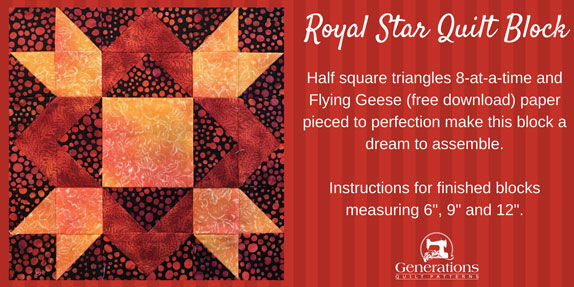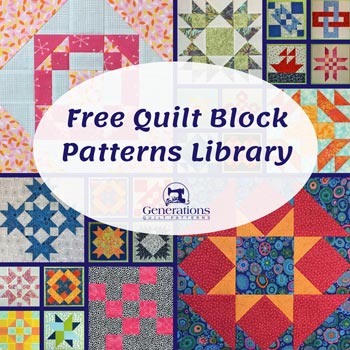- Home
- Free Quilt Block Patterns
- Royal Star Quilt Block
The Majestic Royal Star Quilt Block
From our Free Quilt Block Patterns Library
This post contains affiliate links, for which I receive compensation.
Show off your quilting skills with the Royal Star Quilt Block—easily stitched using paper pieced Flying Geese pairs and half square triangles stitched with the 8-at-a-time method.
Let's sew together an epic masterpiece fit for royalty.
On this page you'll find:
- Cutting instructions in 3 sizes
- A similar block if you'd prefer to skip the Flying Geese
And if you don't have time to quilt today, Pin this tutorial for later.
It's to to cut up and sew!
📋 General Instructions
Several abbreviations are used on this page. They are:
- SA - seam allowance
- RST - right sides together
- HST - half square triangles
- Bac - Background fabric
1/4" SA are used through this tutorial.
When instructed to press, first press the patches in the closed position just as they came off your sewing machine.
This sets the seam, melding the fibers of the threads into the fibers of the fabric.
Then press the SA to the dark unless otherwise noted.
Paperpieced seams are always pressed towards the last patch added.
Download and print paperpiecing patterns
You'll need the most current version of Adobe installed on your computer to download the pattern.
On the Adobe Print Menu page, under 'Page Size and Handling' set 'Custom Scale' to 100% before printing for accurate results. Click here to see what it looks like on the Print Menu page.
Choose your finished block size from the chart below and print the corresponding number of pages for a total of four Flying Geese Pair units.
Print the Flying Geese Pair Units | ||
|---|---|---|
| Finished Block Size | # of copies | Link to PDF Download |
| 6" | 1 | 2" |
| 9" | 1 | 3" |
| 12" | 2 | 4" |

Not sure which paper to use?
Take a look at my review of several of the most popular brands available to us quilters on the market.
You want a super-easy paper to tear away—less stress on the stitches.
After printing, use the 1" square graphic on the printed page(s) the patterns printed at the correct size.
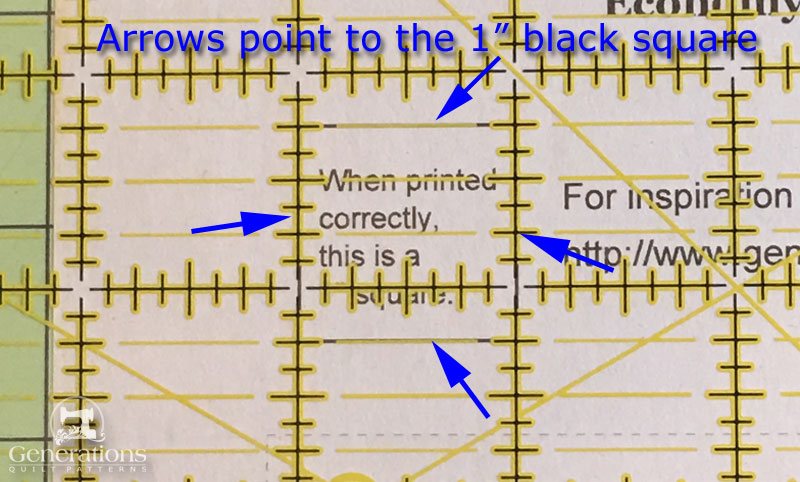 Check that your units are the correct size before going any further.
Check that your units are the correct size before going any further.Cut out the units a bit past the outside dashed lines. There are no brownie points for cutting on the line.
Step 1: Cutting for a Royal Star quilt block
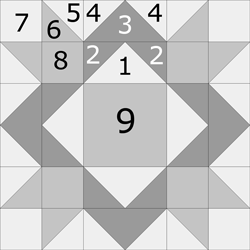 Royal Star design
Royal Star designSample Block: 9" finished / 9-1/2" unfinished
Grid: 6x6
Design Type: Even 9-patch | Star
Remember to label your patches after cutting. The half and quarter square triangles for the double Flying Geese (#2 and #3) are very close in size.
For the sample block a dark background fabric is used, even though a light is shown in the block drawing. That's because I think it's easier to see on the drawing.
It's fun to experiment. How will you color YOUR block?
 | Cutting Chart for a~Traditional Plus Paper Piecing ~ | |||||
|---|---|---|---|---|---|---|
| Patch | Fabric | Qty | Finished Block Size | Sub Cut | ||
| 6" | 9" | 12" | ||||
| 1 | Bac | 1 | 3⅝" x 3⅝" | 4⅝" x 4⅝" | 5⅝" x 5⅝" | |
| 2 | Dark | 4 | 2⅜" x 2⅜" | 2⅞" x 2⅞" | 3⅜" x 3⅜" | |
| 3 | Dark | 1 | 3⅝" x 3⅝" | 4⅝" x 4⅝" | 5⅝" x 5⅝" | |
| 4 | Bac | 4 | 2⅜" x 2⅜" | 2⅞" x 2⅞" | 3⅜" x 3⅜" | |
| 5 | Bac | 1 | 4¼" x 4¼" | 5¼" x 5¼" | 6¼" x 6¼" | -- |
| 6 | Med | 1 | 4¼" x 4¼" | 5¼" x 5¼" | 6¼" x 6¼" | -- |
| 7 | Bac | 4 | 1½" x 1½" | 2" x 2" | 2½" x 2½" | -- |
| 8 | Med | 4 | 1½" x 1½" | 2" x 2" | 2½" x 2½" | -- |
| 9 | Med | 1 | 2½" x 2½" | 3½" x 3½" | 4½" x 4½" | -- |
| Unfinished Block Size | 6½" | 9½" | 12½" | -- | ||
| Grid Size | 1" | 1½" | 2" | -- | ||
Step 2: Piecing the different units in your Royal Star
Flying Geese Pairs
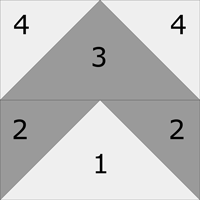
Make 4
Paperpiecing is an efficient way to make pairs of Flying Geese—you only have to trim the pair at the end instead of trimming each Goose as you go along.
And even better, those points don't get cut off!
Use a dab of Elmer's Washable Glue Stick to stick the backside of a #1 patch to the unprinted side of your paperpiecing pattern. Use the dashed placement lines for quick, fool-proof positioning.
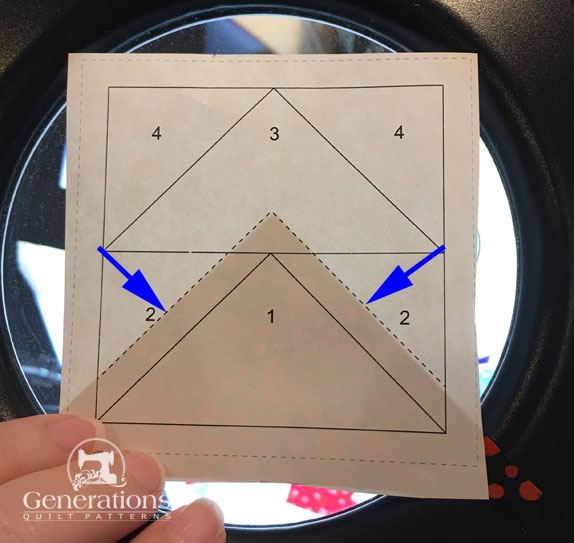
General Sewing Machine Setup for Paperpiecing
- Reduce your stitch length to 16–20 stitches per inch (1.3-1.6 mm). This perforates the paper and stabilizes the seam when you remove the pattern. [Learn more about stitch length here.]
- Reduce your machine's speed or just plain slow down. Sew only as fast as you can stay on the stitching lines.
- Install an open toe appliqué foot (sometimes called an 'embroidery' or 'satin stitch' foot) if you have one (it's easier to see where you're stitching with one installed).
- Use a larger needle (90/14) if you have problems removing the pattern.
- If your machine has a needle stop up, use it. The stitching goes faster when you don't have to lift the presser foot with every seam.
- As you stitch each seam, start and stop a generous 1/4” before and after the solid stitching lines. ALWAYS. Future lines of stitching secure the ends.
After adding each patch, press the unit as it was sewn to set the seam and then open. The SA is automatically pressed towards the last patch added.
Before adding the next patch, take a look to make sure the one you just added covers the space plus seam allowance that it is supposed to.
Steam is optional and usually curls the pattern.
If that bothers you, don't use steam. Sometimes I do. Sometimes I don't.
It truly depends on my mood.
Remember, as you follow this paper piecing tutorial, the printed and the fabric sides of this block are mirror-images of each other.
At last!
Let's sew!
With RST, line up the raw edges of #1 and the first #2 patch.
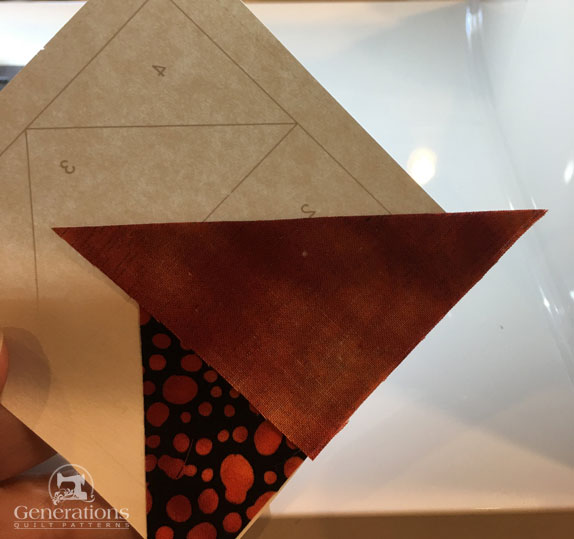
Start your stitching starting a bit more than a 1/4" from the solid line between #1 and #2. End a generous 1/4" past the solid line.
Future stitches secure this stitch line.
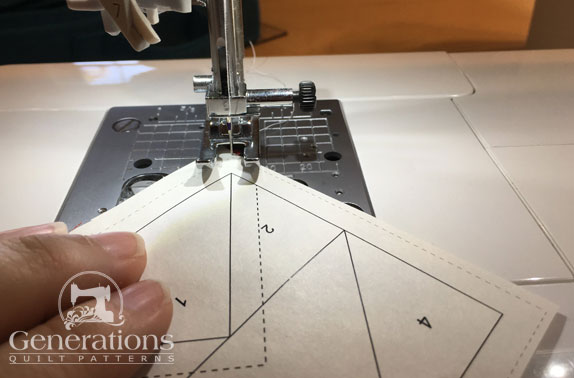
With RST, align the raw edges of the second #2 and #1 patch. Stitch as before.
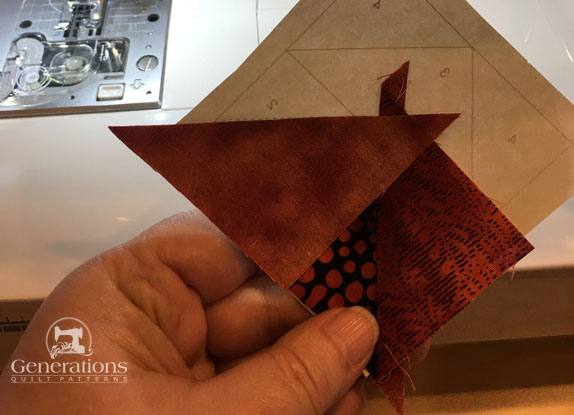
Repeat for all four units.
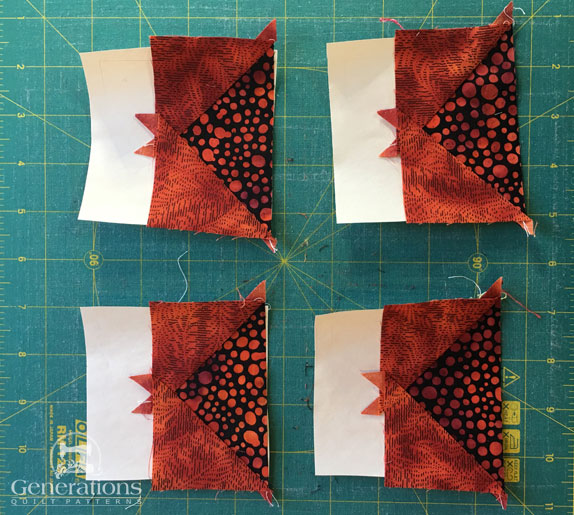
Trim to establish the next SA by lining up the ruler with the solid line between the #2s and #3. Fold the paper back on itself along this line and crease with your finger.
You will need to pull the pattern away from the stitches. The paper may rip a bit...that's normal. If it's too much, use a bit of Scotch Tape to repair the pattern. Don't iron the tape.
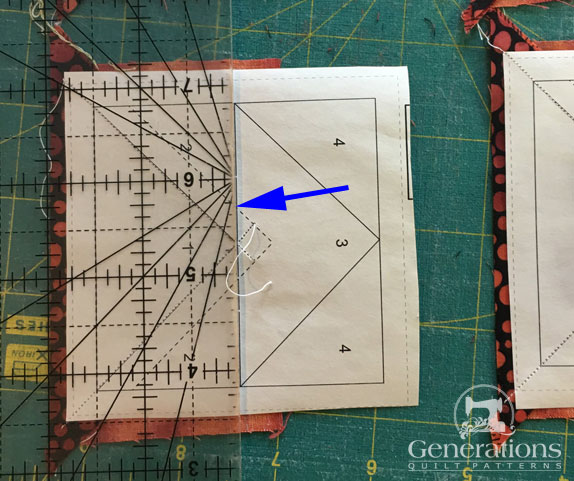
Now align the 1/4" mark on your ruler with the fold. The ruler extends a 1/4" past to create your SA. Trim away excess fabric.
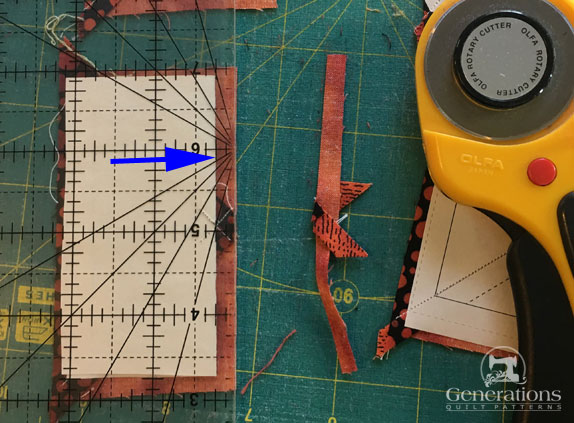
Beautiful, isn't it?!!
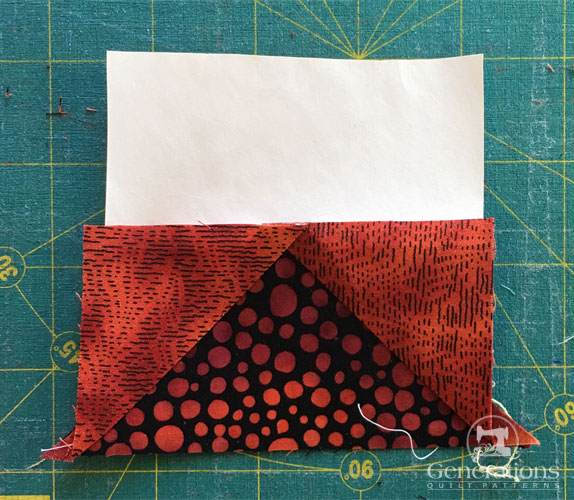
Position the #3 even with the cut edge for perfect placement.
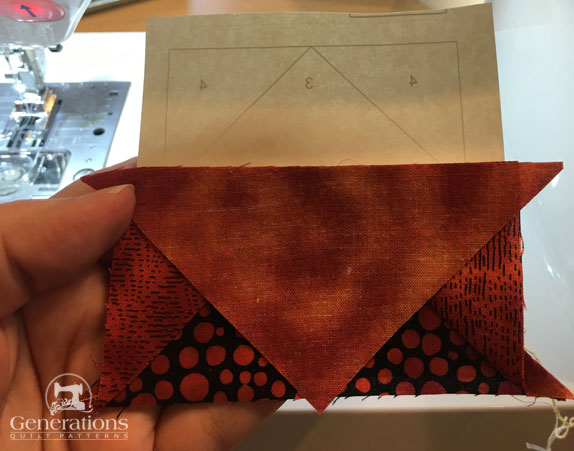
Stitch.
Time to trim again.
This time you'll fold and then trim a 1/4" past the two lines between the #3 and #4s.
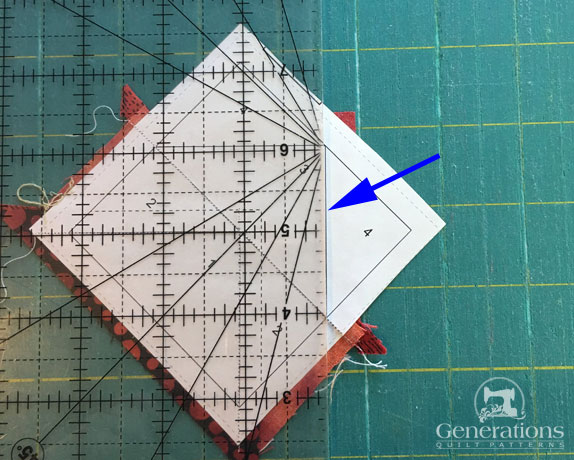
Establishing the quarter inch seam...
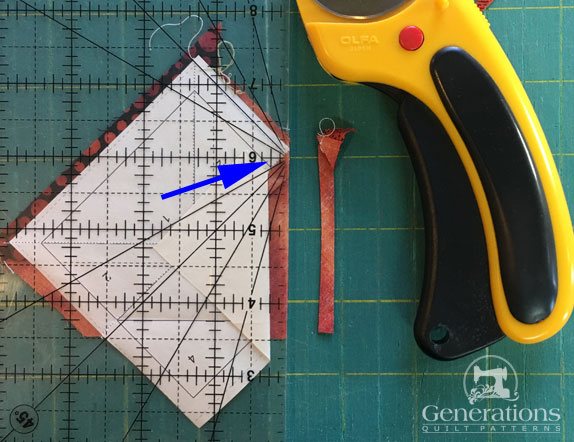
Add the final two #4 patches. This is what the units look like before trimming to perfection.
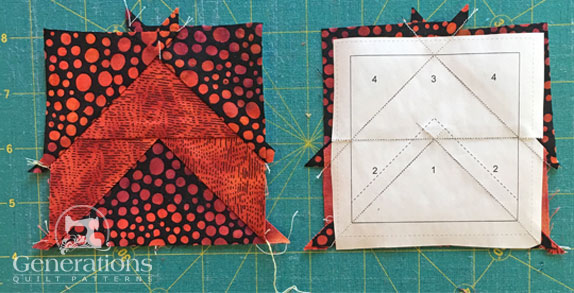
Trim to size by placing the 1/4" ruler marking along the outside solid line and trimming off the excess with your rotary cutter. Repeat for all four sides of all four units.
Remove the paper.
Here they are all ready for our Royal Star block.
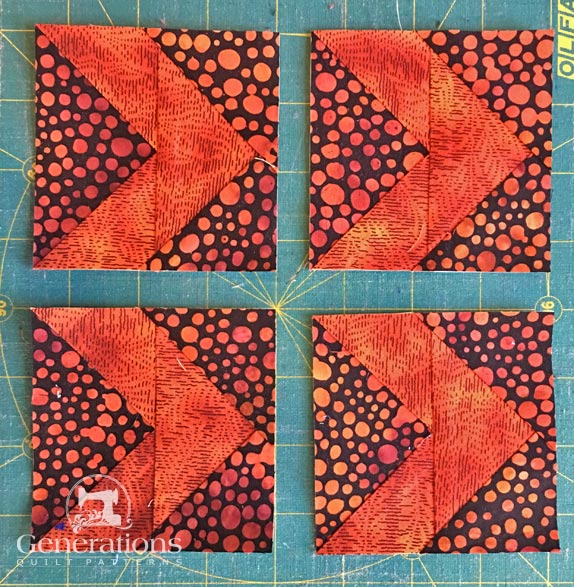
HSTs
Make 8
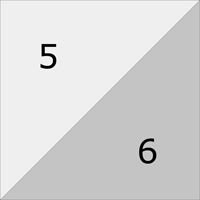
We use the 8-at-a-time method for making our HSTs.
If you plan to make many blocks, you may want to use another HST method like triangle paper.
Switch to your favorite quarter inch foot for the remainder of the stitching. Increase your stitch length to the one your normally use for piecing—no paper to perforate now!
Choose either the #5 or #6 square and draw two diagonal lines on the back from corner to corner—pick the fabric that's easier to see your lines on. (I love the Bohin Mechanical chalk pencil for this.)
With RST, stitch a quarter away from both sides of both lines.
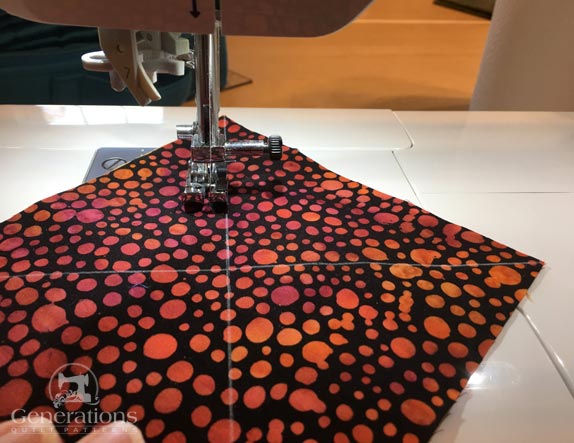
Give the unit a quick press to make it nice and flat.
Next we cut the pair of squares (#5/#6) into four equal smaller squares.
In the chart below find the Center Measurement that corresponds to your chosen 'Finished Block Size'.
HST Dimensions | ||
|---|---|---|
| Finished Block Size | Center Measurement | Trim HST to… |
| 6" | 2-1/8" | 1-1/2" |
| 9" | 2-5/8" | 2" |
| 12" | 3-1/8" | 2-1/2" |
At the cutting mat (I love a rotating mat for this cutting because I can swivel the mat instead of disturbing the patches), align the Center Measurement mark on your ruler with the edge of your block. Cut through the center.
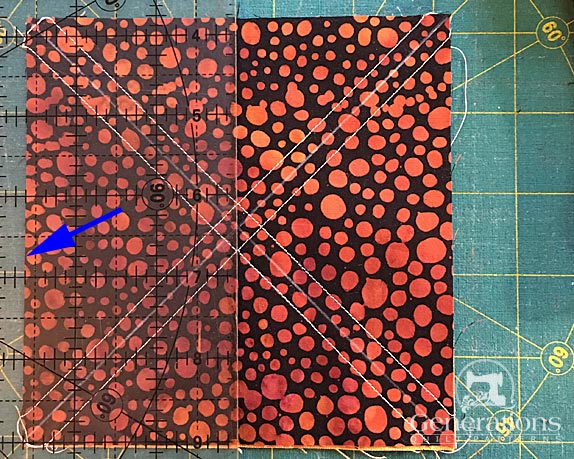 For our 9" finished sample block, the Center measurement is 2-5/8".
For our 9" finished sample block, the Center measurement is 2-5/8".Turn the block a quarter turn (that's where the rotating mat comes in handy. Nothing moves except the board), align the Center measurement with the edge again and cut. You now have 4 equal squares.
Cut each square in half on each diagonal to create eight HST.
Here they are!
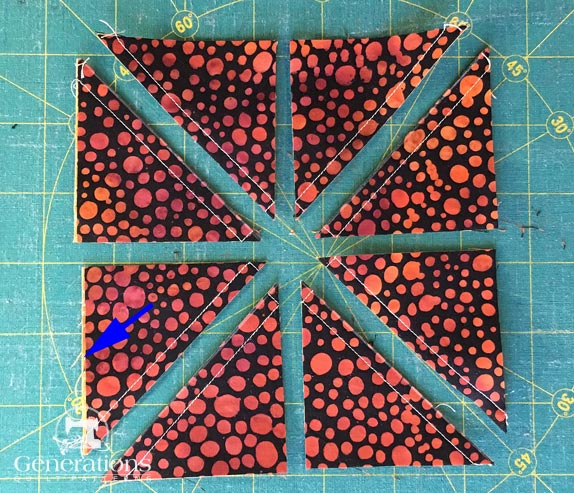 All that's left is the pressing and trimming!
All that's left is the pressing and trimming!SAs are pressed toward the darker fabric.
Returning to the chart, find the 'Trim to' measurement that goes with your block and trim your units to perfection.
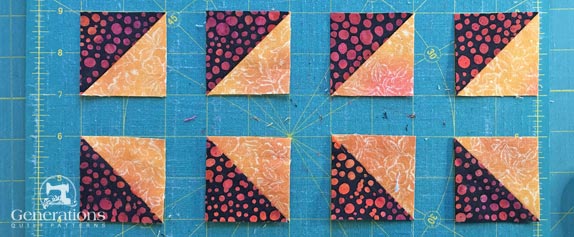 The HSTs are trimmed to 2"x2" for our 9" sample.
The HSTs are trimmed to 2"x2" for our 9" sample.Corners
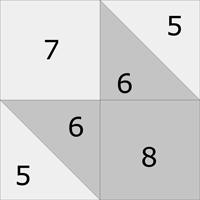
Make 4
With RST, stitch a #8 to a HST and a #7 to another HST.
SA are pressed in the direction of the arrows.
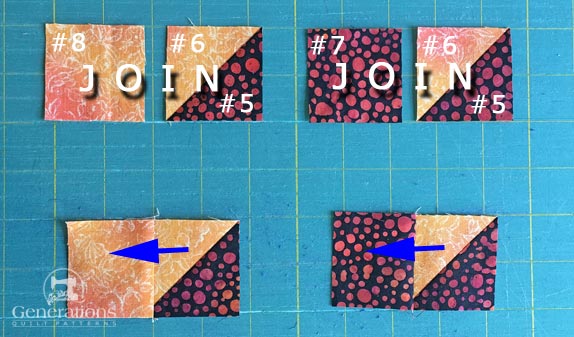
With RST sew the two pairs together, then press SA in the direction of the arrows.
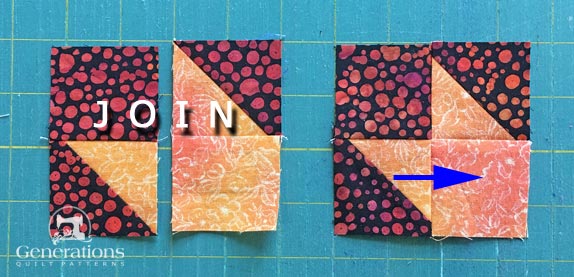
Repeat for the three remaining pairs.
Step: Assemble the Royal Star quilt block
Arrange your patches into the Royal Star design—the background squares are in the outside corners, the medium squares are toward the center.
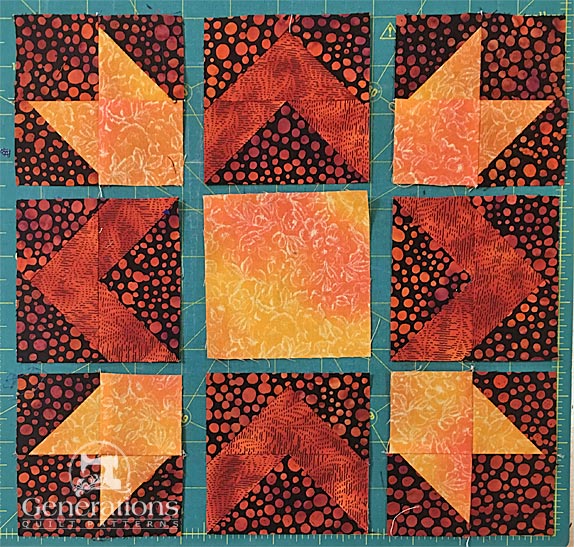 Did you catch it?
Did you catch it?The Flying Geese (bottom row) is upside down...always good to double check!
With RST, stitch the units into rows. SAs are pressed in the direction of the arrows so that they'll nest. That makes matching seams easier.
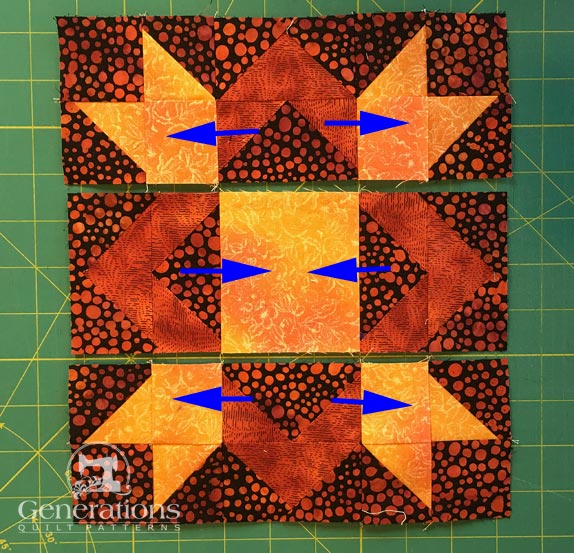
Press.
And finally stitch the rows together, pinning as you need.
Give your Royal Star a final press (try my favorite pressing technique for hands-down the flattest block you'll ever see.)
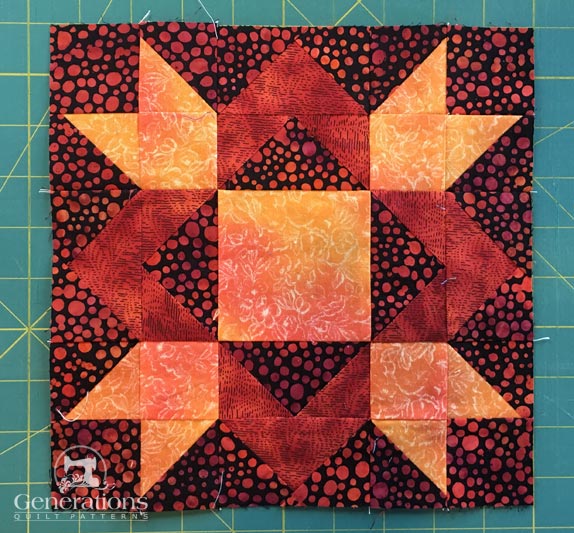 Presto! Our Royal Star quilt block is complete!
Presto! Our Royal Star quilt block is complete!An alternative to the Royal Star quilt block
While I love paper piecing Flying Geese pairs for their accuracy, I recognize that many don't care to paper piece.
If that's you, may I suggest the Weathervane block. It's virtually the same block—without a goose in sight.
Find the instructions for it here.
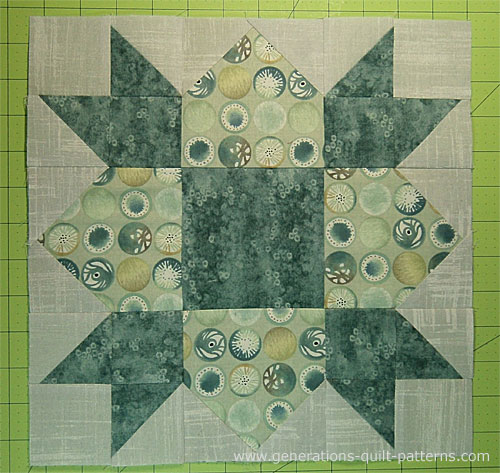 A gooseless Weathervane block
A gooseless Weathervane block🔭 Looking for something truly stellar?
You've finished your star quilt block, and you're ready for more!
Browse our collection of 70 stellar star quilt block patterns. All have instructions and cutting charts in multiple sizes. If templates or paper piecing is used in the tutorial, there's a free download for you of those materials.
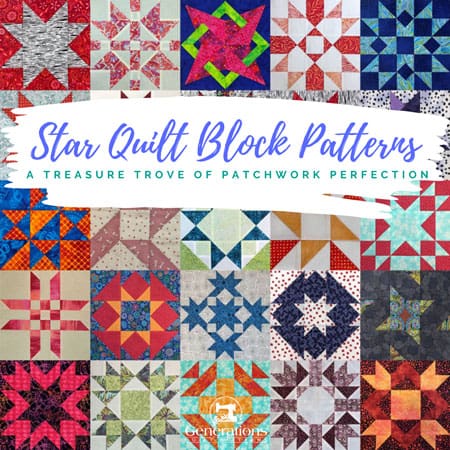
Eeny. Meenie. Miney. Moe.
Which star quilt block will you sew?
For a star-studded quilting experience, choose from 100+ bedazzling star quilt patterns—for beginners and beyond—click here.
For even MORE blocks to make… 🧩🎨

...visit our Free Quilt Block Pattern Library, with over 260+ blocks to choose from in multiple sizes.
Free downloads are included in all sizes for any blocks require paper piecing patterns or templates.
Behind every quilter is a huge pile of fabric...
The only way to whittle it down is to MAKE MORE QUILTS!!!
Look to our free Quilt Block Patterns Library for inspiration for your next quilting project!
- Home
- Free Quilt Block Patterns
- Royal Star Quilt Block
